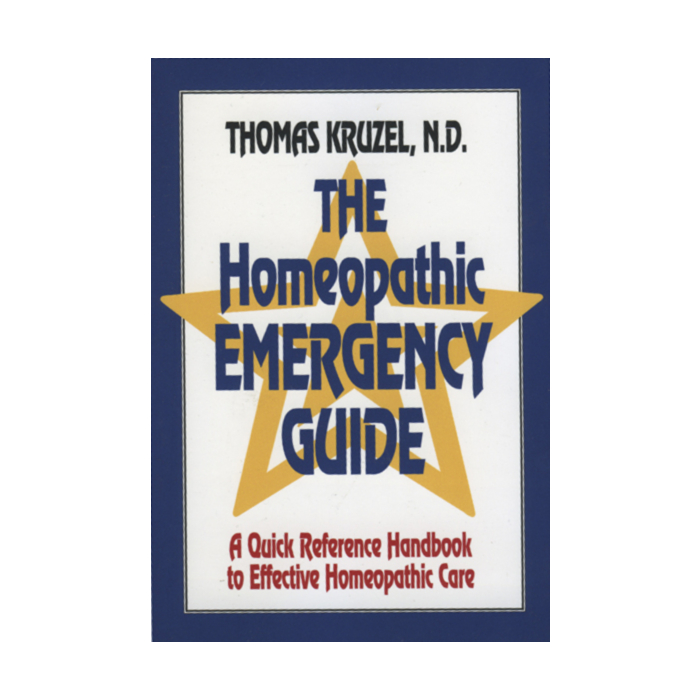The Homeopathic Emergency Guide
Share on social media
As homeopathic medicine becomes more available, increasing numbers of clinicians, families and patients are learning how to use these natural medicines to treat common ailments. Using homeopathic medicines, however, is not as simple as matching symptoms with remedies. To get the best results with homeopathic medicines, it is essential to individalize a remedy according to the pattern of symptoms shown in the sick person. Dr. Kruzel's Homeopathic Emergency Guide is a quick and reliable handbook.
| Subtitle | A quick reference handbook to effective homeopathic care |
|---|---|
| ISBN | 9781556431234 |
| Author | Thomas Kruzel |
| Type | Paperback |
| Language | English |
| Publication Date | 1993-01-29 |
| Pages | 366 |
| Publisher | North Atlantic Books |
| Review | This book review is reprinted with the permission of the American Institute of Homeopathy Under each remedy, its specific symptoms pertaining to the clinical condition under consideration are detailed, followed by modalities related to the local symptoms. Central symptoms are printed in bold type. The foreword by Andre Saine and the introduction by the author provide ample warning regarding the dangers of prescribing upon specific conditions as opposed to general indications and modalities; consequently, the book is not to be misconstrued as advocating specific prescribing. Rather it is another book written in a format similar to such books as Dewey's Practical Homeopathic Therapeutics, Tyler's Pointers, Lilienthal's Homeopathic Therapeutics, Bell's Diarrhea, Guernsey's Obstetrics, etc. The book is concise, well-organized, and thorough. I believe it will be of considerable service to the homeopathic community, especially to newer homeopaths and students, and I recommend it to them. For myself, I should have far more relished a treatment of the topics written in a more prose like style and incorporating more of the author's personal experience. I can site Nash's Testimony of the Clinic as an illustration of a style that reads less like an encyclopedia of symptoms. In fact, in some instances I find Dr. Kruzel's coverage of each remedy to be somewhat too extensive, diluting in consequence the central image of a remedy, that which is to be compared with other competing remedies. Consequently, I can recommend The Homeopathic Emergency Guide less as a comparative materia medica for specific clinical conditions, which in fact it is not intended to be, and more as a reference guide to be used as the author suggests: first take a full case, then repertorize to narrow the remedy choices, and then, if one is by the nature of the case confined to the process of selecting the most appropriate remedy for a local clinical condition, refer to the text for a description of the remedies in question. Dr. Kruzel has labored admirably to produce a useful and practical text, one that I can recommend to students and homeopathic clinicians alike. It should prove a valuable quick reference manual, especially for acute disorders. JAIH Summer 1993, Vol. 86, No. 2 |
Review
This book review is reprinted with the permission of the American Institute of Homeopathy
Reviewed by George Guess, MD
Dr. Kruzel has crafted "a quick reference handbook to effective homeopathic care." This book is intended to serve as a desktop reference for students and clinicians of homeopathy to facilitate ready access to principle remedies for specific conditions. Each chapter corresponds to a different condition or symptom. Remedy descriptions are then provided. The remedies included in each chapter appear to be selected based upon either their prominence in related rubrics in Kent's Repertory or the author's experience and reading.
Under each remedy, its specific symptoms pertaining to the clinical condition under consideration are detailed, followed by modalities related to the local symptoms. Central symptoms are printed in bold type.
The foreword by Andre Saine and the introduction by the author provide ample warning regarding the dangers of prescribing upon specific conditions as opposed to general indications and modalities; consequently, the book is not to be misconstrued as advocating specific prescribing. Rather it is another book written in a format similar to such books as Dewey's Practical Homeopathic Therapeutics, Tyler's Pointers, Lilienthal's Homeopathic Therapeutics, Bell's Diarrhea, Guernsey's Obstetrics, etc.
The book is concise, well-organized, and thorough. I believe it will be of considerable service to the homeopathic community, especially to newer homeopaths and students, and I recommend it to them.
For myself, I should have far more relished a treatment of the topics written in a more prose like style and incorporating more of the author's personal experience. I can site Nash's Testimony of the Clinic as an illustration of a style that reads less like an encyclopedia of symptoms. In fact, in some instances I find Dr. Kruzel's coverage of each remedy to be somewhat too extensive, diluting in consequence the central image of a remedy, that which is to be compared with other competing remedies.
Consequently, I can recommend The Homeopathic Emergency Guide less as a comparative materia medica for specific clinical conditions, which in fact it is not intended to be, and more as a reference guide to be used as the author suggests: first take a full case, then repertorize to narrow the remedy choices, and then, if one is by the nature of the case confined to the process of selecting the most appropriate remedy for a local clinical condition, refer to the text for a description of the remedies in question.
Dr. Kruzel has labored admirably to produce a useful and practical text, one that I can recommend to students and homeopathic clinicians alike. It should prove a valuable quick reference manual, especially for acute disorders.
JAIH Summer 1993, Vol. 86, No. 2

